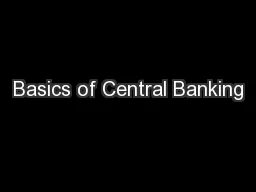

amp Origins of Central Banking Dr D Foster ECO 473 Money amp Banking Free Banking amp Inflation No government control No government regulation Entry and exit is free Subject only to legal requirement to pay off debts ID: 678348
Download Presentation The PPT/PDF document "Basics of Central Banking" is the property of its rightful owner. Permission is granted to download and print the materials on this web site for personal, non-commercial use only, and to display it on your personal computer provided you do not modify the materials and that you retain all copyright notices contained in the materials. By downloading content from our website, you accept the terms of this agreement.
Slide1
Basics of Central Banking&Origins of Central Banking
Dr. D. Foster – ECO 473 – Money & BankingSlide2
Free Banking & Inflation
No government control.
No government regulation.Entry and exit is free.
Subject only to legal requirement to pay off debts.Slide3
What limits excess bank note issue?
Trust.
Extent to which we use bank notes.Fear of a bank run.
If loans are sound, then bank should be able to liquidate without loss to depositors.Once started it is impossible to stop.
Limited clientele as a day-to-day restraint.Conclusion:
Free banking non-inflationarySlide4
Other Free Banking Issues
Forces at work to consolidate; weakens restraint.But, forming cartels is quite unlikely.
International gold flows would still limit a monopoly bank.Hume/Ricardo “specie flow price mechanism.”Fractional reserve banking as causing boom/bust cycle.
Mises:
“[F]reedom in the issuance of banknotes
[will narrow] down the use of banknotes…”Slide5
Central Banking
Government privilege or control.Monopoly on note issue.Tend to centralize holding of gold.
Can prevent individual bank collapse.Will expand (contract) the MS by expanding (contracting) bank reserve deposits.Assuming banks are “fully loaned up” the MS is: Notes in circulation + (1/rr
)*(Bank reserves)
Since banks earn their profits by creating new money
and lending it out, banks will keep fully loaned up
unless
highly unusual circumstances
prevail. (136)Slide6
Free Banking vs. Central Banking
With free banking
what happens to the MS whendepositors cash out some of their DD for banknotes?
Nothing. Only the form of the MS changes;
from DD to banknotes.Slide7
Free Banking vs. Central Banking
With central banking
what happens to the MS whendepositors cash out some of their DD for banknotes?
The bank loses liabilities to the CB.
To restore reserve balance, loans, DD and MS must fall.Slide8
Central Banking – The Bank of England
Created in 1694
Bought gov’t bonds and issued notes.
Held all government debt.
Notes were not “legal tender,” but widely accepted.Insolvent in 2 years.Parliament allowed them to suspend specie payment.
Brief competition (Nat’l Land Bank; South Seas)1708: monopoly on bank notes & short term loans.Late 1700s, massive suspension lasted 24 years.
1833: notes made legal tender.Peel Act – limit fractional reserve notes
Failed to recognize deposits as money.Slide9
Basics of Central Banking&Origins of Central Banking
Dr. D. Foster – ECO 473 – Money & Banking